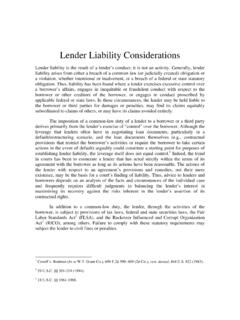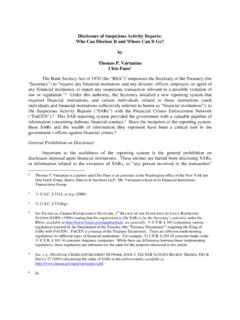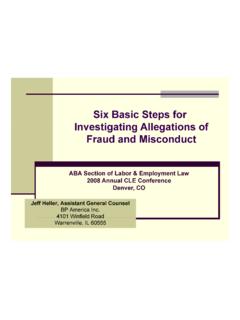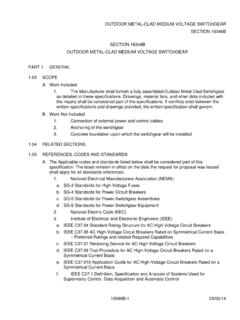Transcription of THE FRONT OF THE CONTRACT - American Bar …
1 C H A P T E R. 1. THE FRONT OF THE. CONTRACT . The body of the CONTRACT that which the parties are agreeing to is preceded by the title, the introductory clause, any recitals, and the lead-in, as well as a cover sheet and related features, as appropriate. (Regarding FRONT - loading the practice of pulling select provisions out of the body of a commercial CONTRACT and placing them at the top of the CONTRACT see ). THE TITLE. The title of a CONTRACT is generally placed at the top cen- ter of the first page, in all capital letters (see sample 1). (Nothing would be gained by using, instead or in addition, another form of emphasis.) The title should simply state, without using a definite or indefinite article, the kind of agreement involved whether it's an employment agreement, option agreement, or some other kind of agreement.
2 Don't include party names in the title. Be concise. For example, don't use a title that looks at a given transaction from different perspectives, as in AGREEMENT OF PURCHASE AND SALE it goes without saying that a purchase necessarily also entails a sale. And don't feel obligated to track the terminology of state statutes. For example, statutes in Nevada, New York, and some other states use the term plan of merger. As a result, it's commonplace for drafters to give merger agreements a title that includes, in some manner, the phrase plan of merger. But if you were to file in Nevada articles of merger that are accompanied by, or refer to, a merger agreement bearing the title MERGER AGREEMENT rather than, say, the more cumbersome AGREEMENT AND PLAN OF MERGER, 1.
3 1 7/17/08 9:56:21 AM. 2 A MANUAL OF STYLE FOR CONTRACT DRAFTING. the Nevada Secretary of State wouldn't reject the articles of merger for using improper terminology they're sensibly enough of the view that there's no particular significance to the term plan of merger, and that if a merger agreement contains the information that the statute requires of a plan of merger, it doesn't matter what the agreement's called. The same would apply with respect to a certificate of merger filed in New York, and it's appropriate to assume that other states would be equally rational. Similarly, don't let use of the term plan of exchange . in state statutes governing share exchanges dissuade you from using the title SHARE EXCHANGE AGREEMENT.
4 Rather than SHARE EXCHANGE AGREEMENT AND PLAN. OF EXCHANGE or something similar. But don't be too concise: giving a CONTRACT the title PUR- CHASE AGREEMENT leaves one wondering what's being sold assets, securities, or something else? And don't use just AGREEMENT unless you can't come up with a more informative title, either because the CONTRACT in question is unusual or because it contains a heterogeneous mix of provisions. Most contracts use the word agreement in the title rather than CONTRACT , perhaps because agreement sounds more gen- teel. By tradition, contracts stating the terms of bonds, de- bentures, or trusts often use the term indenture; see If a company routinely enters into a given kind of CONTRACT , it might want to supplement the title, for instance by adding additional information in parentheses immediately below the title.
5 For example, it might be helpful to specify beneath the title TRADEMARK LICENSE AGREEMENT which mark is being licensed, and in which territory. (Alternatively, such information could be frontloaded; see ). Regarding the title to give amendments or amended and restated contracts, see THE INTRODUCTORY CLAUSE. The title is followed by the introductory clause, which states the type of agreement involved, the date of the agreement, and the parties to the agreement (see sample 1). 2 7/17/08 9:56:23 AM. CHAPTER 1 THE FRONT OF THE CONTRACT 3. SAMPLE 1 TITLE AND INTRODUCTORY CLAUSE. ASSET PURCHASE AGREEMENT. This asset purchase agreement is dated May 3, 2008, and is between HASTINGS.
6 WASTE MANAGEMENT, INC., a Delaware corpora on ( Has ngs ), JORVIK RECYCLING. SYSTEMS, LTD., a New York corpora on ( Has ngs Sub 1 ), ROGER HASTINGS, an individual ( Mr. Has ngs ; together with Has ngs and Has ngs Sub 1, the Has ngs Par es ), and JARROW HOLDINGS LLC, a Delaware limited liability company ( Jarrow ). Format The introductory clause in sample 1 is formatted as a single paragraph; that's the general practice in the The elements of the introductory clause could instead be broken up, or tabulated, so that each stands by itself. (Regarding tabulation of enumerated clauses, see ) In some countries, particularly England and other Commonwealth nations, the preference is for tabulating the introductory clause.
7 This manual doesn't recommend that usage it takes up more space without making the introductory clause appreciably easier to read. Reference to the Type of Agreement Begin the introductory clause by referring again to the type of agreement involved, repeating the wording of the title. And begin the reference with This, with a view to structuring the introductory clause as a sentence, thereby making it easier to read than it would otherwise be. Use all lowercase letters for the introductory clause's reference to the type of agreement involved. It would be distracting to emphasize it with all capital letters, given that the title, which occurs immediately above, is in all capital letters (see ).
8 It would also be inappropriate to use initial capitals in this reference or any other reference to a particular CONTRACT , wherever in a CONTRACT that reference is located: a CONTRACT shouldn't be treated like the title of a book or movie, and the words merger agreement in a reference to the merger agreement between Acme and Dynaco are no more deserving of initial capitals than is the word letter in Here's the letter that Aunt Mildred sent me. Initial capitals would be appropriate if the reference 3 7/17/08 9:56:23 AM. 4 A MANUAL OF STYLE FOR CONTRACT DRAFTING. to an agreement were a defined term if, for example, the merger agreement between Acme and Dynaco were given the defined term the Merger Agreement.
9 But the introductory- clause reference to the type of agreement involved doesn't constitute a defined term. (And it shouldn't constitute the definition of a defined term either; see ). Verb If it's to be a sentence, the introductory clause needs a verb. Among the various options, is dated is simpler and clearer than is made or is entered into and is doubly clearer and simpler than is made and entered into. (Regarding redundant synonyms, see ). Date You can date a CONTRACT in one of two ways: you can state the date in the introductory clause or you can instead have those signing the CONTRACT date their signatures and have the CONTRACT state that it will be effective when the last party signs (see 7).
10 Stating the date in the introductory clause is the more usual way of dating a CONTRACT , but dating the signatures makes sense in three contexts. First, although it's commonplace for one or more parties to sign a CONTRACT on a date other than the date stated in the introductory clause (see ), that could be confusing if the discrepancy were more than a few days (see ). Second, for compliance purposes a company might decide to use dated signatures in some or all of its contracts so as to preclude use of an introductory-clause date that is other than the date the last party signed. For example, a company or its outside auditors might require that all the company's sales contracts include dated signatures, the aim being to help ensure that revenue is recognized in the appropriate quarter.
















